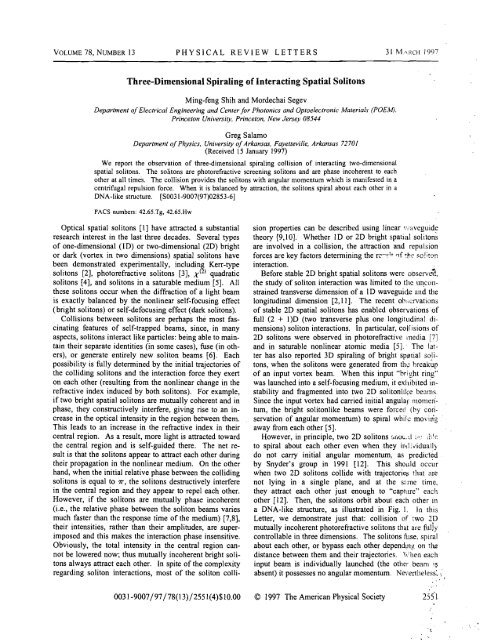Three - University of Arkansas Physics Department
Three - University of Arkansas Physics Department
Three - University of Arkansas Physics Department
You also want an ePaper? Increase the reach of your titles
YUMPU automatically turns print PDFs into web optimized ePapers that Google loves.
VOLUME 78, NUMBER 13 PHYSICAL REVIEW LETTERS 31 MARCH I997<br />
<strong>Three</strong>-Dimensional Spiraling <strong>of</strong> Interacting Spatial Solitons<br />
Ming-feng Shih and Mordechai Segev<br />
<strong>Department</strong> <strong>of</strong> Electrical Engineering and Cenfer for Photonics and Opfoelectronic Malerials (POEkO,<br />
Princeton <strong>University</strong>, Princeton, New Jersey 08544<br />
Greg Salamo<br />
<strong>Department</strong> <strong>of</strong> <strong>Physics</strong>. <strong>University</strong> <strong>of</strong> <strong>Arkansas</strong>, Foyetteville, <strong>Arkansas</strong> 72701<br />
(Received 15 January 1997)<br />
We report the observation <strong>of</strong> three-dimensional spiraling collision <strong>of</strong> interacting two-dimensional<br />
spatial solitons. The solitons are photorefractive screening solitons and are phase incoherent to each<br />
other at all times. The collision provides the solitons with angular momentum which is manifested in a<br />
centrihgal repulsion force. When it is balanced by attraction, the solitons spiral about each other in a<br />
DNA-like structure. [SO03 1-9007(97)02853-61<br />
PACS numbers: 42.65.Tg, 42.65.H~<br />
Optical spatial solitons [I.] have attracted a substantial<br />
research interest in the last three decades. Several types<br />
<strong>of</strong> one-dimensional (ID) or two-dimensional (2D) bright<br />
or dark (vortex in two dimensions) spatial solitons have<br />
been demonstrated experimentally, including Kerr-type<br />
solitons [2], photorefractive solitons [3], X(2) quadratic<br />
solitons [4], and solitons in a saturable medium [5]. All<br />
these solitons occur when the diffraction <strong>of</strong> a light beam<br />
is exactly balanced by the nonlinear self-focusing effect<br />
(bright solitons) or self-defocusing effect (dark solitons).<br />
Collisions between solitons are perhaps the most fascinating<br />
features <strong>of</strong> self-trapped beams, since, in many<br />
aspects, solitons interact like particles: being able to maintain<br />
their separate identities (in some cases), fuse (in others),<br />
or generate entirely new soliton beams [6]. Each<br />
possibility is fully determined by the initial trajectories <strong>of</strong><br />
the colliding solitons and the interaction force they exert<br />
on each other (resulting from the nonlinear change in the<br />
refractive index induced by both solitons). For example,<br />
if two bright spatial solitons are mutually coherent and in<br />
phase, they constructively interfere, giving rise to an increase<br />
in the optical intensity in the region between them.<br />
This leads to an increase in the refractive index in their<br />
central region. As a result, more light is attracted toward<br />
the central region and is self-guided there. The net result<br />
is that the solitons appear to attract each other during<br />
their propagation in the nonlinear medium. On the other<br />
hand, when the initial relative phase between the colliding<br />
solitons is equal to T, the solitons destructively interfere<br />
in the central region and they appear to repel each other.<br />
However, if the solitons are mutually phase incoherent<br />
(i.e., the relative phase between the soliton beams varies<br />
much faster than the response time <strong>of</strong> the medium) [7,8],<br />
their intensities, rather than their amplitudes, are superimposed<br />
and this makes the interaction phase insensitive.<br />
Obviously, the total intensity in the central region cannot<br />
be lowered now; thus mutually incoherent bright solitons<br />
always attract each other. In spite <strong>of</strong> the complexity<br />
regarding soliton interactions, most <strong>of</strong> the soliton colli-<br />
sion properties can be described using linear v!aveguide<br />
theory [9,10]. Whether ID or 2D bright spatial solitons<br />
are involved in a collision, the attraction and repulsion<br />
forces are key factors determining the rc-;!!+ qf ~hc sc!h<br />
interaction.<br />
Before stable 2D bright spatial solitons were observd,<br />
the study <strong>of</strong> soliton interaction was limited to the unconstrained<br />
transverse dimension <strong>of</strong> a 1 D waveguide and the<br />
longitudinal dimension [2,11]. The recent ohxcrvations<br />
<strong>of</strong> stable 2D spatial solitons has enabled observations :<strong>of</strong><br />
full (2 + l)D (two transverse plus one longitiidinal dimensions)<br />
soliton interactions. In particular, collisions <strong>of</strong><br />
2D solitons were observed in photorefractive inedia [7]<br />
and in saturable nonlinear atomic media [S]. ' The latter<br />
has also reported 3D spiraling <strong>of</strong> bright spatial solitons,<br />
when the solitons were generated from th~ breakbp<br />
<strong>of</strong> an input vortex beam. When this input "bright ring"<br />
was launched into a self-focusing medium, it exhibited instability<br />
and fragmented into two 2D solitonlil.;e beams.<br />
Since the input vortex had carried initial angula: ~i~orneritum,<br />
the bright solitonlike beams were forcetl (by conservation<br />
<strong>of</strong> angular momentum) to spiral whilc moviig<br />
away from each other [5].<br />
However, in principle, two 2D solitons !>~io~,:.l I>'!:<br />
to spiral about each other even when they individuall)<br />
do not cany initial angular momentum, as predicted<br />
by Snyder's group in 1991 [12]. This should occur<br />
when two 2D solitons collide with trajectorieg that are<br />
not lying in a single plane, and at the same time,<br />
they attract each other just enough to "capture" each<br />
other [12]. Then, the solitons orbit about each other in<br />
a DNA-like structure, as illustrated in Fig. 1. In this<br />
Letter, we demonstrate just that: collision <strong>of</strong> two 2D<br />
mutually incoherent photorefractive solitons that are fully<br />
,<br />
controllable in three dimensions. The solitons fuse. spiral<br />
about each other, or bypass each other depending on t h<br />
distance between them and their trajectories. Khen each<br />
input beam is individually launched (the other beam 15<br />
absent) it possesses no angular momentum. Nevertheless: :<br />
003 1 -9007/97/78(13)/255 1(4)$10.00 O 1997 The American Physical Society 2551.













